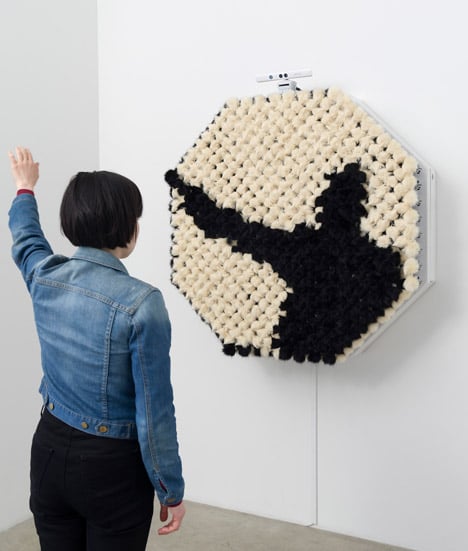- Please discuss the project. What do you admire about it, and why do you admire these aspects of it?
One of the interactive projects I remembered is Daniel Rozin’s PomPom Mirror. The project contains a mirror made of black and white fur, which reflects the audience’s silhouette by pushing the furs using many motors. The most fascinating aspect of the project is the material. The fur moves slowly yet smoothly, displaying interesting patterns when they’re switching between black and white. The delay creates an expectation. Furthermore, while most mirrors are hard and shiny, this mirror creates an unfamiliarity as well as a novel feeling by being organic and fluffy. Moreover it only display very rough silhouettes, giving audience space for imagination. I also enjoyed the idea of “pixels” taken out of the context of screens.
- How many people were involved in making it, and how did they organize themselves to achieve it? (Any idea how long it took them to create it?)
1 people is credited, but I can not find information on whether the artist has helpers. I think it takes a long time to install all the motors.
- How was the project created? What combination of custom software/scripts, or “off-the-shelf” software, did the creators use? Did they develop the project with commercial software, or open-source tools, or some combination?
The project uses fur puffs, motors and Kinect. Kinect detects people and custom software translates the detection into motion of the motors, which then move the fur.
- What prior works might the project’s creators have been inspired by?
I think mirrors and the idea of seeing one self has always been something fascinating to human beings, and people are writing and making things about them since ancient time. (e.g. Snow White, Perseus, etc). The artist himself also makes a lot of mirrors, and some of them are made before this one, such as Wood Mirror (1999) and Peg Mirror (2007).
- To what opportunities or futures does the project point, if any?
Mirrors of other materials. Moving furs that interacts with audience differently.
- Provide a link (if possible) to the artwork, and a full author and title reference.
link: http://www.smoothware.com/danny/index.html
- Embed an image and a YouTube/Vimeo video of the project (if available).
image:

video:
- Create a brief animated GIF for the project, if a video is available. (For advice, information and resources about how to make an animated GIF, please see this page.) Keep your GIF around 640×480 pixels (absolutely no wider than 840 pixels), and under 5Mb.
